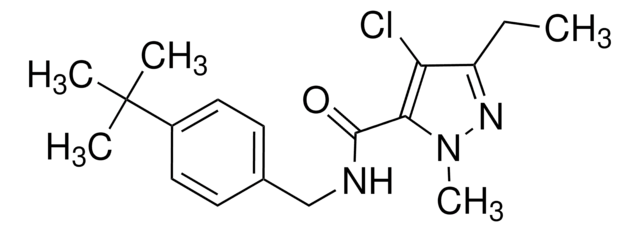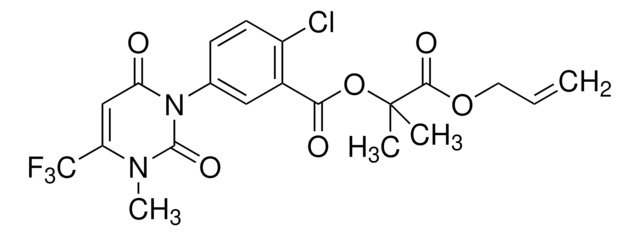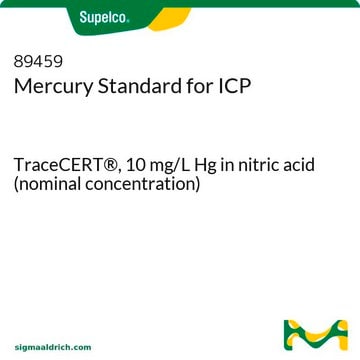CRM52554
Spiroxamine
certified reference material, TraceCERT®, Manufactured by: Sigma-Aldrich Production GmbH, Switzerland
Synonyme(s) :
N-Ethyl-N-propyl-8-tert-butyl-1,4-dioxaspiro[4.5]dec-2-ylmethylamine
About This Item
Produits recommandés
Qualité
certified reference material
TraceCERT®
Niveau de qualité
Gamme de produits
TraceCERT®
Durée de conservation
limited shelf life, expiry date on the label
Fabricant/nom de marque
Manufactured by: Sigma-Aldrich Production GmbH, Switzerland
Format
neat
Température de stockage
2-8°C
Chaîne SMILES
CCCN(CC)CC1COC2(CCC(CC2)C(C)(C)C)O1
InChI
1S/C18H35NO2/c1-6-12-19(7-2)13-16-14-20-18(21-16)10-8-15(9-11-18)17(3,4)5/h15-16H,6-14H2,1-5H3
Clé InChI
PUYXTUJWRLOUCW-UHFFFAOYSA-N
Vous recherchez des produits similaires ? Visite Guide de comparaison des produits
Description générale
Certified content by quantitative NMR incl. uncertainty and expiry date are given on the certificate.
Download your certificate at: http://www.sigma-aldrich.comSpiroxamine is a systemic fungicide that belongs to the class of synthetic amines or morpholines. It targets the ∆14-reductase enzyme and inhibits sterol biosynthesis. It is used against powdery mildew, rust, and spot fungi on cereals and grapes for its protective, curative, and eradicative activities.
As per Regulation (EC) No. 1107/2009, repealing directive 91/414/EEC, spiroxamine is approved for use in the European Union (EU). A maximum residue limit (MRL) of 0.01 mg/kg and 0.05 mg/kg is applicable for the presence of spiroxamine in fresh/frozen fruits and tree nuts respectively, in accordance with Regulation (EC) No. 2016/452. Spiroxamine is to be monitored in the Multiannual Control Programme for Pesticides Residues (MACP), run within the EU and EFTA in/on products of plant origin.
Application
The spiroxamine CRM may also find the following uses:
- Development of an enantioselective method to determine three fungicide residues in grapevine, sugar beet, and wheat samples by gas chromatography-tandem mass spectrometry (GC-MS/MS)
- Quantification of 19 neonicotinoids and fungicides from pollen and individual bumblebee samples using modified QuEChERS extraction with ultra-high performance liquid chromatography-tandem mass spectrometry (UHPLC-MS/MS)
- Evaluation of a gas chromatographic method with electron capture and nitrogen phosphorus detection (GC/ECD/NPD) for the analysis of 46 pesticides in fresh peppermint samples
- Multi-residue determination of 25 pesticide residues in red wine by gas chromatography-mass spectrometry(GC-MS)
- QuEChERS extraction and liquid chromatography-tandem mass spectrometry based determination of 42 pesticides in six marijuana samples
- Investigation of three different sample preparation methods to select the most suitable one for the analysis of 98 pesticides in globe artichoke leaves and fruit samples by LC-MS and GC-MS
Informations légales
Mention d'avertissement
Warning
Mentions de danger
Classification des risques
Acute Tox. 4 Dermal - Acute Tox. 4 Inhalation - Acute Tox. 4 Oral - Aquatic Acute 1 - Aquatic Chronic 1 - Repr. 2 - Skin Irrit. 2 - Skin Sens. 1 - STOT RE 2
Organes cibles
Eyes
Code de la classe de stockage
10 - Combustible liquids
Classe de danger pour l'eau (WGK)
WGK 3
Point d'éclair (°F)
296.6 °F
Point d'éclair (°C)
147 °C
Choose from one of the most recent versions:
Certificats d'analyse (COA)
Don't see the Right Version?
If you require a particular version, you can look up a specific certificate by the Lot or Batch number.
Déjà en possession de ce produit ?
Retrouvez la documentation relative aux produits que vous avez récemment achetés dans la Bibliothèque de documents.
Notre équipe de scientifiques dispose d'une expérience dans tous les secteurs de la recherche, notamment en sciences de la vie, science des matériaux, synthèse chimique, chromatographie, analyse et dans de nombreux autres domaines..
Contacter notre Service technique











